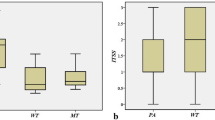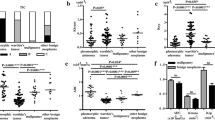Abstract
Purpose
To evaluate the diagnostic performance of histogram parameters derived from diffusion-weighted imaging (DWI) for differentiating malignant from benign parotid gland tumors compared with that of hotspot region of interest (ROI)-based apparent diffusion coefficient (ADC) measurement.
Methods
Our study retrospectively enrolled 60 patients with parotid gland tumors who had undergone DWI scan for pre-treatment evaluation. ADC measurements were performed using hotspot ROI (ADCHS-ROI)-based and histogram-based approach. Histogram parameters included mean (ADCmean), median (ADCmedian), 10th (ADC10), 90th (ADC90) percentiles, skewness and kurtosis of ADC. Mann–Whitney U test, Kruskal–Wallis test with post hoc Dunn–Bonferroni method and receiver operating characteristic (ROC) curve analyses were used for statistical analyses.
Results
ADCHS-ROI and ADC histogram parameters showed no significant differences between malignant and benign parotid gland tumors (All Ps > 0.05). Within the sub-group analyses, Warthin’s tumors showed the lowest ADCHS-ROI, ADCmean, ADCmedian, ADC10 and ADC90 value, followed by malignant tumors and pleomorphic adenomas (All Ps < 0.05). ADC10 out-performed ADCHS-ROI in differentiating malignant tumors from pleomorphic adenomas (area under curve, 0.890 vs 0.821; sensitivity, 79.31 vs 82.76%; specificity, 90.91 vs 72.73%; P = 0.016), and improved the diagnostic performance in differentiating malignant tumors from Warthin’s tumors (area under curve, 1.000 vs 0.965; sensitivity, 100.00 vs 90.91%), although the difference was not significant (P = 0.348).
Conclusions
ADC histogram analysis, especially ADC10, might be a promising imaging biomarker for characterizing parotid gland tumors.


Similar content being viewed by others
References
El-Naggar AK (2017) WHO classification of tumors of salivary glands. In: El-Naggar AK, Chan JKC, Grandis JR, Takata T, Slootweg PJ (eds) WHO classification of head and neck tumours, 4th edn. IARC, Lyon, p 160
Takumi K, Fukukura Y, Hakamada H et al (2017) Value of diffusion tensor imaging in differentiating malignant from benign parotid gland tumors. Eur J Radiol 95:249–256
Yabuuchi H, Matsuo Y, Kamitani T et al (2008) Parotid gland tumors: can addition of diffusion-weighted MR imaging to dynamic contrast-enhanced MR imaging improve diagnostic accuracy in characterization? Radiology 249:909–916
Habermann CR, Arndt C, Graessner J et al (2009) Diffusion-weighted echo-planar MR imaging of primary parotid gland tumors: is a prediction of different histologic subtypes possible? AJNR Am J Neuroradiol 30:591–596
Lee YYP, Wong KT, King AD, Ahuja AT (2008) Imaging of salivary gland tumours. Eur J Radiol 66:419–436
Eida S, Sumi M, Nakamura T (2010) Multiparametric magnetic resonance imaging for the differentiation between benign and malignant salivary gland tumors. J Magn Reson Imaging 31:673–679
Jansen JF, Parra C, Lu YG, Shukla-Dave A (2016) Evaluation of head and neck tumors with functional MR imaging. Magn Reson Imaging Clin N Am 24:123–133
Kikuchi M, Koyasu S, Shinohara S, Imai Y, Hino M, Naito Y (2016) Preoperative diagnostic strategy for parotid gland tumors using diffusion-weighted MRI and technetium-99m pertechnetate scintigraphy: a prospective study. PLoS One 11:e0148973
Eida S, Sumi M, Sakihama N, Takahashi H, Nakamuraet T (2007) Apparent diffusion coefficient map** of salivary gland tumors: prediction of the benignancy and malignancy. AJNR Am J Neuroradiol 28:116–121
Mukai H, Motoori K, Horikoshi T et al (2016) Basal cell adenoma of the parotid gland; MR features and differentiation from pleomorphic adenoma. Dentomaxillofac Radiol 45:20150322
Yuan Y, Tang W, Tao X (2016) Parotid gland lesions: separate and combined diagnostic value of conventional MRI, diffusion-weighted imaging and dynamic contrast-enhanced MRI. Br J Radiol 89:20150912
Xu XQ, Hu H, Su GY et al (2016) Utility of histogram analysis of ADC maps for differentiating orbital tumors. Diagn Interv Radiol 22:161–167
Suo ST, Zhang KB, Cao MQ et al (2016) Characterization of breast masses as benign or malignant at 3.0T MRI with whole-lesion histogram analysis of the apparent diffusion coefficient. J Magn Reson Imaging 43:894–902
Zhang YD, Wu CJ, Wang Q et al (2015) Comparison of utility of histogram apparent diffusion coefficient and R2* for differentiation of low-grade from high-grade clear cell renal cell carcinoma. AJR Am J roentgenol 205:W193–W201
Xu XQ, Ma G, Wang YJ et al (2017) Histogram analysis of diffusion kurtosis imaging of nasopharyngeal carcinoma: correlation between quantitative parameters and clinical stage. Oncotarget 8:47230–47238
Liang HY, Huang YQ, Yang ZX, Ying D, Zeng MS, Rao SX (2015) Potential of MR histogram analyses for prediction of response to chemotherapy in patients with colorectal hepatic metastases. Eur J radiol 26:2009–2018
DeLong ER, DeLong DM, Clarke-Pearson DL (1988) Comparing the areas under two or more correlated receiver operating characteristic curves: a nonparametric approach. Biometrics 44:837–845
Fruehwald-Pallamar J, Czerny C, Holzer-Fruehwald L et al (2013) Texture-based and diffusion-weighted discrimination of parotid gland lesions on MR images at 3.0 T. NMR Biomed 26:1372–1379
Sumi M, Van CM, Sumi T, Obara M, Ichikawa Y, Nakamura T (2012) Salivary gland tumors: use of intravoxel incoherent motion MR imaging for assessment of diffusion and perfusion for the differentiation of benign from malignant tumors. Radiology 263:770–777
Ikeda M, Motoori K, Hanazawa T et al (2004) Warthin tumor of the parotid gland: diagnostic value of MR imaging with histopathologic correlation. AJNR Am J Neuroradiol 25:1256–1262
Tao X, Yang G, Wang P et al (2017) The value of combining conventional, diffusion-weighted and dynamic contrast-enhanced MR imaging for the diagnosis of parotid gland tumours. Dentomaxillofac Radiol 46:20160434
Xu XQ, Hu H, Su GY, Liu H, Shi HB, Wu FY (2016) Diffusion weighted imaging for differentiating benign from malignant orbital tumors: diagnostic performance of the apparent diffusion coefficient based on region of interest selection method. Korean J Radiol 17:650–656
Funding
This work was supported by National Natural Science Foundation of China (81771796 to FY Wu), and Jiangsu Province’s Young Medical Talents Program (QNRC2016560 to Xu XQ).
Author information
Authors and Affiliations
Corresponding authors
Ethics declarations
Conflict of interest
The authors declare that they have no conflict of interest.
Rights and permissions
About this article
Cite this article
Ma, G., Zhu, LN., Su, GY. et al. Histogram analysis of apparent diffusion coefficient maps for differentiating malignant from benign parotid gland tumors. Eur Arch Otorhinolaryngol 275, 2151–2157 (2018). https://doi.org/10.1007/s00405-018-5052-y
Received:
Accepted:
Published:
Issue Date:
DOI: https://doi.org/10.1007/s00405-018-5052-y




